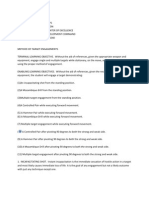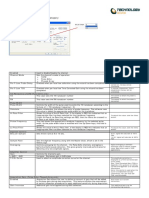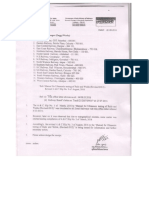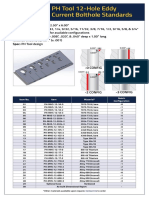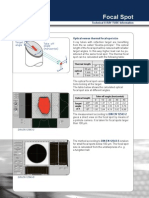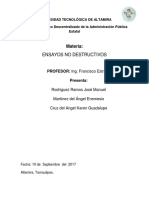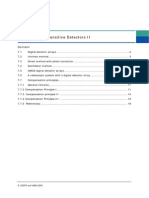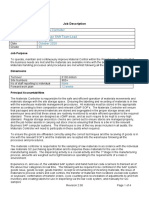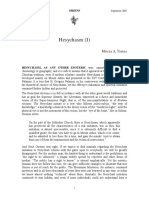Professional Documents
Culture Documents
DATASHEET Up1542r
DATASHEET Up1542r
Uploaded by
joao doisssOriginal Title
Copyright
Available Formats
Share this document
Did you find this document useful?
Is this content inappropriate?
Report this DocumentCopyright:
Available Formats
DATASHEET Up1542r
DATASHEET Up1542r
Uploaded by
joao doisssCopyright:
Available Formats
uP1542
5V/12V Synchronous-Rectified Buck Controller
General Description Features
The uP1542 is a compact synchronous-rectified buck Operates from 5V or 12V Supply Voltage
controller specifically designed to operate from 5V or 12V 3.3V to 12V VIN Input Range
supply voltage and to deliver high quality output voltage
as low as 0.6V for uP1542S/U (linear OCP). VREF with 1.0% Accuracy:
The uP1542 adopts constant frequency, voltage mode uP1542S/U: 0.6V VREF
control scheme, featuring easy-to-use, low external uP1542T/Q/V: 0.8V VREF
component count, and fast transient response. Fixed
Stand Alone Mode Operation
300kHz operation provides an optimal level of integration
to reduce size and cost of the power supply. Simple Single-Loop Control Design
This controller integrates internal MOSFET drivers that Voltage-Mode PWM Control
support 12V+12V bootstrapped voltage for high efficiency Fast Transient Response
power conversion. The bootstrap diode is built-in to simplify
Fixed 300kHz Switching Frequency
the circuit design and minimize external part count.
Other features include internal soft start, over/under High-Bandwidth Error Amplifier
voltage protection, over current protection and shutdown 0% to 90% Duty Cycle
function. With aforementioned functions, this part provides Lossless, Adjuatable Over Current Protection
customers a compact, high efficiency, well-protected and
cost-effective solutions. This part is available in PSOP- Uses Lower MOSFET RDS(ON)
8L and WDFN2x2-8L package. uP1542S/U: Linear OCP
uP1542T/Q/V: Fixed OCP
Pin Configuration
Internal Soft Start
BOOT 1 8 PH Integrated Boot Diode
UG 2 9 7 COMP/EN PSOP-8L and WDFN2x2-8L Package
OCS 3 GND 6 FB RoHS Compliant and Halogen Free
LG 4 5 VCC
Applications
PSOP-8L (uP1542S)
Power Supplies for Microprocessors or
Subsystem Power Supplies
BOOT 1 8 PH Cable Modems, Set Top Boxes, and DSL Modems
UG 2 9 7 COMP/EN Industrial Power Supplies; General Purpose
GND 3 GND 6 FB Supplies
LG 4 5 VCC 5V or 12V Input DC-DC Regulators
PSOP-8L (uP1542Q/T/V)
Low-Voltage Distributed Power Supplies
BOOT 1 8 PH
UG 2 7 COMP/SD
GND
OCS 3 6 FB
LG 4 5 VCC
WDFN2x2-8L (uP1542U)
uP1542-DS-F00A0, Apr. 2018 1
www.upi-semi.com
uP1542
Ordering Information
Order Number Package Type VREF Remark Top Marking
uP1542SSU8 0.6V linear OCP uP1542S
uP1542TSU8 0.8V fixed OCP@225mV uP1542T
PSOP-8L
uP1542QSU8 0.8V fixed OCP@300mV uP1542Q
uP1542VSU8 0.8V fixed OCP@375mV uP1542V
uP1542UDD8 WDFN2x2-8L 0.6V linear OCP DJ
Note:
(1) Please check the sample/production availability with uPI representatives.
(2) uPI products are compatible with the current IPC/JEDEC J-STD-020 requirement. They are halogen-free,
RoHS compliant and 100% matte tin (Sn) plating that are suitable for use in SnPb or Pb-free soldering processes.
Functional Pin Description
Pin Name Pin Function
B ootstrap Supply for the floati ng upper gate dri ver. C onnect the bootstrap capaci tor between
BOOT BOOT pin and the PH pin to form a bootstrap circuit. The bootstrap capacitor provides the charge
to turn on the upper MOSFET.
Upper Gate Driver Output. Connect this pin to the gate of upper MOSFET. This pin is monitored
UG by the adaptive shoot-through protection circuitry to determine when the upper MOSFET has turned
off.
GND Ground.
OCS Over Current Protection Setting. Connect a resistor from this pin to GND to set the OCP level.
Low er Gate Driver Output. Connect this pin to the gate of lower MOSFET. This pin is monitored
LG by the adaptive shoot-through protection circuitry to determine when the lower MOSFET has turned
off.
Supply Voltage. This pin provides the bias supply for the uP1542 and the lower gate driver. Connect
VC C a well-decoupled 4.5V to 13.2V supply voltage to this pin. Ensure that a decoupling capacitor is
placed near the IC.
Feedback Voltage. This pin is the inverting input to the error amplifier. A resistor divider from the
FB output to GND is used to set the regulation voltage. Use this pin in combination with the COMP/EN
pin to compensate the voltage control feedback loop of the converter.
Error Amplifier Output. This is the output of the error amplifier and the non-inverting input of the
PWM comparator. Use this pin in combination with the FB pin to compensate the voltage-control
COMP/EN
feedback loop of the converter. Pulling COMP/EN to a level below 0.3V disables the controller and
causes the oscillator to stop, the UG and LG outputs to be held low.
PHASE Sw itch Node. Connect this pin to the source of the upper MOSFET and the drain of the
lower MOSFET. This pin is used as the sink for the UG driver, and to monitor the voltage drop across
PH
the lower MOSFET for over current protection. This pin is also monitored by the adaptive shoot-
through protection circuitry to determine when the upper MOSFET has turned off.
Ground. The exposed pad is the dominate heat conducting path and should be well soldered to the
Exposed Pad
PCB with multiple vias for optimal thermal performance.
2 uP1542-DS-F00A0, Apr. 2018
www.upi-semi.com
uP1542
Typical Application Circuit
VIN
VCC UG
GND BOOT
PH VOUT
COMP/EN
LG R1
Shut
Down
FB
OCS
R2
Functional Block Diagram
OCS VCC
4.2V
Enable Enable POR VDD Internal
Soft Start POR BOOT
Logic Regulator
SS
Protection
0.3V
VOCP UG
1.0V OCP
COMP/EN
FB PWM Gate
Error Control PH
Amplifier PWM Logic
Comparator VCC
VREF
0.6V/uP1542S/U
Oscillator LG
VFB VFB GND
OVP UVP
1.25xVREF 0.3xVREF
uP1542-DS-F00A0, Apr. 2018 3
www.upi-semi.com
uP1542
Functional Description
The uP1542 is a compact synchronous-rectified buck 1V
controller specifically designed to operate from 5V or 12V
0.3V
supply voltage and to deliver high quality output voltage
COMP/EN
as low as 0.6V. Chip
Disable Enable
Supply Voltage
FB
The VCC pin receives a well-decoupled 4.5V to 13.2V Enable
uP1542
supply voltage to power the control circuit, the lower gate VREF
Error
driver and the bootstrap circuit for the higher gate driver. Amplifier
A minimum 1uF ceramic capacitor is recommended to
bypass the supply voltage. Place the bypassing capacitor Figure 1. Chip Enable Function
physically near the IC. Soft Start
An internal linear regulator regulates the supply voltage A built-in Soft Start is used to prevent surge current from
into a 4.2V voltage VDD for internal control logic circuit. power supply input during turn on (referring to the
No external bypass capacitor is required for filtering the Functional Block Diagram). The error amplifier is a three-
VDD voltage. input device. Reference voltage VREF or the internal soft
The uP1542 integrates MOSFET gate drives that are start voltage SS whichever is smaller dominates the
powered from the VCC pin and support 12V+12V driving behavior of the non-inverting inputs of the error amplifier.
capability. A bootstrap diode is embedded to facilitate PCB SS internally ramps up to VCC and the output voltage will
design and reduce the total BOM cost. No external follow the SS signal and ramp up smoothly to its target
Schottky diode is required. Converters that consist of level.
uP1542 feature high efficiency without special The SS signal keeps ramping up after it exceeds the
consideration on the selection of MOSFETs. reference voltage VREF. However, the reference voltage
Note: The embedded bootstrap diode is not a VREF takes over the behavior of error amplifier after SS >
Schottky diode having a 0.8V forward voltage. VREF. When the SS signal climb to 1.3 x VREF, the uP1542
External Schottky diode is highly recommended if the claims the end of softstart cycle and enables the over and
VCC voltage is expected to be lower than 5.0V. under voltage protection of the output voltage.
Otherwise the bootstrap diode may be too low for the Figure 2 shows a typical start up interval for uP1542 where
device to work normally. the COMP/SD pin has been released from a grounded
Power On Reset and Chip Enable (system shutdown) state.
A power on reset (POR) circuitry continuously monitors The internal 80uA current source starts to charge the
the supply voltage at VCC pin. Once the rising POR compensation network after the COMP/SD pin is released
threshold is exceeded, the uP1542 sets itself to active from grounded at T1. The COMP/SD exceeds 0.3V and
state and is ready to accept chip enable command. The enables the uP1542 at T2. The COMP/SD continues
rising POR threshold is typically 4.2V at VCC rising. ramping up and stays at 1V before the SS starts ramping
up at T3. The uP1542 initializes itself such as current limit
The COMP/EN is a multifunctional pin: control loop
level setting (see the relative section) during the time
compensation and chip enable as shown in Figure 1. An
interval between T2 and T3. The output voltage follows
Enable Comparator monitors the COMP/EN pin voltage
the internal SS and ramps up to its final level during T3
for chip enable. A signal level transistor is adequate to
and T4. At T4, the reference voltage VREF takes over the
pull this pin down to ground and shut down the uP1542. behavior of the error amplifier as the internal SS crosses
An 80uA current source charges the external VREF. The internal SS keeps ramping up and reaches 1.3 x
compensation network with 1.0V ceiling when this pin is VREF at T5, where the uP1542 asserts the end of softstart
released. If the voltage at COMP/EN pin exceeds 0.3V, cycle.
the uP1542 initiates its softstart cycle.
The 80uA current source keeps charging the COMP pin
to its ceiling until the feedback loop boosts the COMP pin
higher than 0.8V according to the feedback signal. The
current source is cut off when VCOMP is higher than 1.0V
during normal operation.
4 uP1542-DS-F00A0, Apr. 2018
www.upi-semi.com
uP1542
Functional Description
Ramp COMP/EN Figure 3. Softstart where VIN does not Present Initially.
Output Voltage Selection
0.3V
SS The output voltage can be programmed to any level
VREF between the reference voltage VREF up to the 90% of VIN
VOUT supply. The lower limitation of output voltage is caused by
the internal reference. The upper limitation of the output
voltage is caused by the maximum available duty cycle
(90% typical). This is to leave enough time for over current
T1 T3 T4 T5
detection. Output voltage out of this range is not allowed.
T2
An voltage divider sets the output voltage (refer to the
Typical Application Circuit on page 3 for detail). In real
COMP (1V/Div) applications, choose R1 in 1kΩ ~ 10kΩ range and choose
appropriate R2 according to the desired output voltage.
R1 + R2
VOUT (1V/Div) VOUT = VREF ×
R2
Over Current Protection (OCP)
The uP1542 detects voltage drop across the lower
LGATE (10V/Div)
MOSFET (VPHASE) for over current protection when it is
turned on. If VPHASE is lower than the user-programmable
voltage VOCP, the uP1542 asserts OCP and shuts down
the converter. The OCP level can be programmed by OCS
pin (uP1542S/U) or fixed at 300mV (uP1542Q).
Time 2ms/Div
The uP1542 sources a 20uA current source out of OCS
Figure 2. Softstart Behavior of uP1542. pin. Connect resistor ROCS at OCS pin to create voltage
Power Input Detection level VOCS for OCP setting. The maximum of VOCP should
not be larger than 375mV.
The uP1542 detects PH voltage for the present of power
input when the UG turns on the first time. If the PH voltage 20uA × R OCS
does not exceed 1.0V when the UG turns on, the uP1542 VOCS =
4
asserts that power input in not ready and stops the softstart
cycle. Another softstart cycle is initiate after a 6ms time
delay. Figure 4 shows the start up interval where VIN does VOCP = VOCS
not present initially.
VOCP
IOCP = (A)
RDS( ON)
For example:
If VOCP = 375mV, and RDS(ON) = 10mΩ, the IOCP will be 37.5A.
VIN (5V/Div)
If VOCP = 225mV, and RDS(ON) = 10mΩ, the IOCP will be 22.5A.
VOUT (1V/Div) Over Voltage and Under Voltage Protection
The uP1542 asserts over voltage protection if the feedback
voltage VFB is higher than 125% of reference voltage VREF.
The uP1542 asserts under voltage protection if the
feedback voltage VFB is lower than 30% of reference
LGATE (10V/Div)
voltage VREF after soft start end. The uP1542 turns off
IL (5A/Div) both higher and lower gate drivers upon UVP and turns
on lower gate driver upon OVP. Both UVP and OVP are
Time 4ms/Div latch-off type and can be reset by POR or toggling the
COMP/EN pin.
uP1542-DS-F00A0, Apr. 2018 5
www.upi-semi.com
uP1542
Absolute Maximum Rating
(Note 1)
Supply Input Voltage, VCC -------------------------------------------------------------------------------------- -0.3V to +15V
BOOT to PH --------------------------------------------------------------------------------------------------------------------- -0.3V to +15V
PH to GND
DC ------------------------------------------------------------------------------------------------------------------------- -0.7V to 15V
< 200ns --------------------------------------------------------------------------------------------------------------------- -8V to 30V
BOOT to GND
DC --------------------------------------------------------------------------------------------------------------- -0.3V to VCC + 15V
< 200ns ------------------------------------------------------------------------------------------------------------------ -0.3V to 42V
UG to PH
DC------------------------------------------------------------------------------------------------------- -0.3V to (BOOT - PH +0.3V)
<200ns ------------------------------------------------------------------------------------------------ -5V to (BOOT - PH + 0.3V)
LG to GND
DC ---------------------------------------------------------------------------------------------------------- -0.3V to + (VCC + 0.3V)
<200ns ---------------------------------------------------------------------------------------------------------- -5V to VCC + 0.3V
Other Pins -------------------------------------------------------------------------------------------------------------------------- -0.3V to +6V
Storage Temperature Range ----------------------------------------------------------------------------------------------- -65OC to +150OC
Junction Temperature --------------------------------------------------------------------------------------------------------------------- 150OC
Lead Temperature (Soldering, 10 sec) ------------------------------------------------------------------------------------------------ 260OC
ESD Rating (Note 2)
HBM (Human Body Mode) ------------------------------------------------------------------------------------------------------- 2kV
MM (Machine Mode) --------------------------------------------------------------------------------------------------------------- 200V
Thermal Information
Package Thermal Resistance (Note 3)
PSOP-8L θJA ----------------------------------------------------------------------------------------------------------------- 47OC/W
WDFN2x2-8L θJA ---------------------------------------------------------------------------------------------------------- 155OC/W
PSOP-8L θJC ---------------------------------------------------------------------------------------------------------------- 17.9OC/W
WDFN2x2-8L θJC ------------------------------------------------------------------------------------------------------------- 20OC/W
Power Dissipation, PD @ TA = 25OC
PSOP-8L ----------------------------------------------------------------------------------------------------------------------------- 2.13W
WDFN2x2-8L ------------------------------------------------------------------------------------------------------------------------ 0.65W
Recommended Operation Conditions
(Note 4)
Operating Junction Temperature Range ------------------------------------------------------------------------------- -40OC to +125OC
Operating Ambient Temperature Range --------------------------------------------------------------------------------- -40OC to +85OC
Supply Input Voltage, VCC ----------------------------------------------------------------------------------------------------- +4.5V to 13.2V
6 uP1542-DS-F00A0, Apr. 2018
www.upi-semi.com
uP1542
Electrical Characteristics
(VCC = 12V, TA = 25OC, unless otherwise specified)
Parameter Symbol Test Conditions Min Typ Max Units
Supply Input
Supply Voltage VCC 4.5 -- 13.2 V
UG and LG Open, VCC = 12V,
Supply Current ICC -- 3 -- mA
Switching
Quiescent Supply Current ICC_Q VFB = VREF + 0.1V, No Switching -- 1.3 -- mA
Power Input Voltage VIN 3.0 -- 13.2 V
Pow er On Reset
POR Threshold VCCRTH VCC rising 4.0 4.2 4.4 V
POR Hysteresis VCCHYS -- 0.5 -- V
Sw itching Frequency
Free Running Frequency fOSC 270 300 330 kHz
Ramp Amplitude ∆VOSC V C C = 12V -- 3 -- VP-P
Reference Voltage
uP1542S/U 0.594 0.60 0.606 V
Internal Reference Voltage Accuracy V FB
uP1542T/Q/V 0.792 0.800 0.808 V
Error Amplifier
Open Loop DC Gain AO Guaranteed by Design 55 70 -- dB
Gain-Bandwidth Product GBW Guaranteed by Design -- 10 -- MHz
Slew Rate SR Guaranteed by Design 3 6 -- V/us
Transconductance 600 800 1000 uA/V
Output Source Current VFB < VREF 80 120 -- uA
Output Sink Current VFB > VREF 80 120 -- uA
Input Offset Voltage -1.0 0 1.0 mV
Input Leakage Current -- 0.1 1.0 nA
PWM Controller Gate Drivers
Upper Gate Source RUG_SRC IUG = 100mA Source -- 3 5 Ω
Upper Gate Sink RUG_SNK IUG = 100mA Sink -- 1.5 3 Ω
Lower Gate Source RLG_SRC IUG = 100mA Source -- 3 5 Ω
Lower Gate Sink RLG_SNK IUG = 100mA Sink -- 1 2 Ω
uP1542-DS-F00A0, Apr. 2018 7
www.upi-semi.com
uP1542
Electrical Characteristics
Parameter Symbol Test C onditions Min Typ Max U nits
PWM C ontroller Gate D rivers
PH Falli ng to LG Ri si ng D elay VPH < 1.2V to VLG > 1.2V -- 30 -- ns
LG Falli ng to UG Ri si ng D elay VLG < 1.2V to (VUG - VPH ) > 1.2V -- 30 -- ns
Mi ni mum D uty C ycle -- 0 -- %
Maxi mum D uty C ycle 85 90 95 %
Soft Start
from C OMP/EN released to VOUT i n
Soft Start Ti me -- 2.5 -- ms
regulati on
Protection
Under Voltage Protecti on VFB_UVP Percentage of VREF -- 30 -- %
Over Voltage Protecti on VFB_OVP Percentage of VREF -- 125 -- %
Over Voltage Protecti on D elay -- 20 -- us
uP1542T -- -225 --
Over C urrent Threshold V PH uP1542Q -- -300 -- mV
uP1542V -- -375 --
OC P Programmable Range VOCP uP1542S/U -375 -- -100 mV
OC S Source C urrent for OC P
IOCS -- 20 -- uA
Setti ng
OC P D elay Ti me -- 3.33 -- us
D i sable Threshold VCOMP/EN 0.25 0.3 0.35 V
O
Over Temperature Protecti on -- 150 -- C
Note 1. Stresses listed as the above “ Absolute Maximum Ratings” may cause permanent damage to the device.
These are for stress ratings. Functional operation of the device at these or any other conditions beyond
those indicated in the operational sections of the specifications is not implied. Exposure to absolute
maximum rating conditions for extended periods may remain possibility to affect device reliability.
Note 2. Devices are ESD sensitive. Handling precaution recommended.
Note 3. θJA is measured in the natural convection at TA = 25°C on a low effective thermal conductivity test board of
JEDEC 51-3 thermal measurement standard.
Note 4. The device is not guaranteed to function outside its operating conditions.
8 uP1542-DS-F00A0, Apr. 2018
www.upi-semi.com
uP1542
Application Information
Component Selection Guidelines Both MOSFETs have I2R losses and the upper MOSFET
The selection of external component is primarily includes an additional term for switching losses, which
determined by the maximum load current and begins with are largest at high input voltages. The lower MOSFET
the selection of power MOSFET switches. The desired losses are greatest when the bottom duty cycle is near
amount of ripple current and operating frequency largely 100%, during a short-circuit or at high input voltage. These
determines the inductor value. Finally, CIN is selected for equations assume linear voltage current transitions and
its capability to handle the large RMS current into the do not adequately model power loss due the reverse-
converter and COUT is chosen with low enough ESR to recovery of the lower MOSFET’s body diode.
meet the output voltage ripple and transient specification. Ensure that both MOSFETs are within their maximum
Power MOSFET Selection junction temperature at high ambient temperature by
The uP1542 requires two external N-channel power calculating the temperature rise according to package
MOSFETs for upper (controlled) and lower (synchronous) thermal-resistance specifications. A separate heatsink may
switches. Important parameters for the power MOSFETs be necessary depending upon MOSFET power, package
are the breakdown voltage V(BR)DSS, on-resistance RDS(ON), type, ambient temperature and air flow.
reverse transfer capacitance CRSS, maximum current The gate-charge losses are mainly dissipated by the
I DS(MAX) , gate supply requirements, and thermal uP1542 and don’t heat the MOSFETs. However, large gate
management requirements. charge increases the switching interval, TSW that increases
The gate drive voltage is supplied by VCC pin that receives the MOSFET switching losses. The gate-charge losses
4.5V~13.2V supply voltage. When operating with a are calculated as:
PG _ C = VCC × (VCC × (C ISS _ UP + C ISS _ LO ) + VIN × C RSS _ UP )× f OSC
7~13.2V power supply for VCC, a wide variety of
NMOSFETs can be used. Logic-level threshold MOSFET
should be used if the input voltage is expected to drop where CISS_UP is the input capacitance of the upper MOSFET,
below 7V. Caution should be exercised with devices CISS_LOW is the input capacitance of the lower MOSFET, and
exhibiting very low VGS(ON) characteristics. The shoot- CRSS_UP is the reverse transfer capacitance of the upper
through protection present aboard the uP1542 may be MOSFET. Make sure that the gate-charge loss will not
circumvented by these MOSFETs if they have large cause over temperature at uP1542, especially with large
parasitic impedances and/or capacitances that would gate capacitance and high supply voltage.
inhibit the gate of the MOSFET from being discharged
Output Inductor Selection
below its threshold level before the complementary
MOSFET is turned on. Also avoid MOSFETs with Output inductor selection usually is based on the
excessive switching times; the circuitry is expecting considerations of inductance, rated current, size
transitions to occur in under 30ns or so. requirements and DC resistance (DCR).
In high-current applications, the MOSFET power Given the desired input and output voltages, the inductor
dissipation, package selection and heatsink are the value and operating frequency determine the ripple
dominant design factors. The power dissipation includes current:
two loss components: conduction loss and switching loss.
1 V
The conduction losses are the largest component of power ∆IL = VOUT (1 − OUT )
dissipation for both the upper and the lower MOSFETs. fOSC × L OUT VIN
These losses are distributed between the two MOSFETs Lower ripple current reduces core losses in the inductor,
according to duty cycle. Since the uP1542 is operating in ESR losses in the output capacitors and output voltage
continuous conduction mode, the duty cycles for the ripple. Highest efficiency operation is obtained at low
MOSFETs are: frequency with small ripple current. However, achieving
V OUT VIN − VOUT this requires a large inductor. There is a tradeoff between
D UP = ; DLOW = component size, efficiency and operating frequency. A
VIN VIN
reasonable starting point is to choose a ripple current that
The resulting power dissipation in the MOSFETs at
is about 20% of IOUT(MAX).
maximum output current are:
PUP = IOUT
2
× RDS( ON) × DUP + 0.5 × IOUT × VIN × TSW × fOSC There is another tradeoff between output ripple current/
voltage and response time to a transient load. Increasing
PLOW = IOUT
2
× RDS( ON) × DLOW the value of inductance reduces the output ripple current
and voltage. However, the large inductance values reduce
where TSW is the combined switch ON and OFF time.
uP1542-DS-F00A0, Apr. 2018 9
www.upi-semi.com
uP1542
Application Information
the converter’s response time to a load transient. capacitors can also be used, but caution must be exercised
Maximum current ratings of the inductor are generally with regard to the capacitor surge current rating. These
specified in two methods: permissible DC current and capacitors must be capable of handling the surge-current
saturation current. Permissible DC current is the allowable at power-up. Some capacitor series available from reputable
DC current that causes 40OC temperature raise. The manufacturers are surge current tested.
saturation current is the allowable current that causes 10% Output Capacitor Selection
inductance loss. Make sure that the inductor will not The selection of COUT is primarily determined by the ESR
saturate over the operation conditions including required to minimize voltage ripple and load step
temperature range, input voltage range, and maximum transients. The equivalent ripple current into the output
output current. capacitor is half of the inductor ripple current while the
The size requirements refer to the area and height equivalent frequency is double of phase operation
requirement for a particular design. For better efficiency, frequency due to two phase operation The output ripple
choose a low DC resistance inductor. DCR is usually ∆VOUT is approximately bounded by:
inversely proportional to size.
∆IL 1
Input Capacitor Selection ∆VOUT = (ESR + )
2 16 × fOSC × COUT
The synchronous-rectified Buck converter draws pulsed
Since ∆IL increases with input voltage, the output ripple is
current with sharp edges from the input capacitor, resulting
highest at maximum input voltage. Typically, once the ESR
in ripples and spikes at the input supply voltage. Use a
requirement is satisfied, the capacitance is adequate for
mix of input bypass capacitors to control the voltage
filtering and has the necessary RMS current rating. Multiple
overshoot across the MOSFETs. Use small ceramic
capacitors placed in parallel may be needed to meet the
capacitors for high frequency decoupling and bulk
ESR and RMS current handling requirements.
capacitors to supply the current needed each time upper
MOSFET turns on. Place the small ceramic capacitors The load transient requirements are a function of the slew
physically close to the MOSFETs to avoid the stray rate (di/dt) and the magnitude of the transient load current.
inductance along the connection trace. These requirements are generally met with a mix of
The important parameters for the bulk input capacitor are capacitors and careful layout. Modern components and
the voltage rating and the RMS current rating. For reliable loads are capable of producing transient load rates above
operation, select the bulk capacitor with voltage and current 1A/ns. High frequency capacitors initially supply the
ratings above the maximum input voltage and largest RMS transient and slow the current load rate seen by the bulk
current required by the circuit. The capacitor voltage rating capacitors. The bulk filter capacitor values are generally
should be at least 1.25 times greater than the maximum determined by the ESR (Effective Series Resistance) and
input voltage and a voltage rating of 1.5 times is a voltage rating requirements rather than actual capacitance
conservative guideline. The RMS current rating requirements.
requirement for the input capacitor of a buck converter is High frequency decoupling capacitors should be placed
calculated as: as close to the power pins of the load as physically
possible. Be careful not to add inductance in the circuit
VOUT ( VIN − VOUT ) board wiring that could cancel the usefulness of these
IIN(RMS ) = IOUT(MAX )
VIN low inductance components. Consult with the
This formula has a maximum at VIN = 2VOUT, where IIN(REMS) manufacturer of the load on specific decoupling
= IOUT(RMS)/2. This simple worst-case condition is commonly requirements.
used for design because even significant deviations do Use only specialized low-ESR capacitors intended for
not offer much relief. Note that the capacitor switching-regulator applications for the bulk capacitors.
manufacturer’s ripple current ratings are often based on The bulk capacitor’s ESR will determine the output ripple
2000 hours of life. This makes it advisable to further derate voltage and the initial voltage drop after a high slew-rate
the capacitor, or choose a capacitor rated at a higher transient. An aluminum electrolytic capacitor’s ESR value
temperature than required. Always consult the is related to the case size with lower ESR available in
manufacturer if there is any question. larger case sizes.
For a through-hole design, several electrolytic capacitors Bootstrap Capacitor Selection
may be needed. For surface mount designs, solid tantalum An external bootstrap capacitor CBOOT connected to the
10 uP1542-DS-F00A0, Apr. 2018
www.upi-semi.com
uP1542
Application Information
BOOT pin supplies the gate drive voltage for the upper filter (LOUT and COUT), with a double pole break frequency at
MOSFET. This capacitor is charged through the internal FLC and a zero at FESR. The DC Gain of the modulator is
diode when the PH node is low. When the upper MOSFET simply the input voltage (VIN) divided by the peak-to-peak
turns on, the PH node rises to VIN and the BOOT pin rises oscillator voltage £GVOSC.
to approximately VIN + VCC. The boot capacitor needs to The output LC filter introduces a double pole, 40dB/decade
store about 100 times the gate charge required by the gain slope above its corner resonant frequency, and a total
upper MOSFET. In most applications 0.47µF to 1µF, X5R phase lag of 180 degrees. The resonant frequency of the
or X7R dielectric capacitor is adequate. LC filter expressed as:
Feedback Loop Compensation
1
Figure 5 highlights the voltage-mode control loop for a FLC =
synchronous-rectified buck converter consisting of 2π L OUT × COUT
uP1542. The control loop includes a compensator and a The ESR zero is contributed by the ESR associated with
modulator, where the modulator consists of the PWM the output capacitor. Note that this requires that the output
comparator, the power stage amplifier and the output filter; capacitor should have enough ESR to satisfy stability
the compensator consists of the error amplifier and requirements as described in the later sections. The ESR
compensating network. A well-designed feedback loop zero of the output capacitor expressed as:
tightly regulates the output voltage (VOUT) to the reference
voltage VREF with fast response to load/line transient and 1
FESR =
good stability. The goal of the compensation network is to 2π × ESR× COUT
provide and the highest 0dB crossing frequency and
Figure 6 illustrates frequency response of a typical
adequate phase margin (greater than 45 degrees). It is
modulator using uP1542.
also recommended to manipulate loop frequency
response that its gain crosses over 0dB at a slope of - 80
20dB/dec. 60
VIN 40 LC
Double
Pole
Gain (dB)
20
Driver Modulator
∠VOSC LOUT 0
ESR
PH Zero
VOUT -20
PWM COUT
Comp.
-40
ESR
-60
1.E+02 1.E+03 1.E+04 1.E+05 1.E+06
VREF
VCOMP Compensator Frequency (Hz)
C1 Error
Amp. R3 Figure 6. Frequency Response of Modulator.
R2 C3
R1
C2 2) Compensator Frequency Equations
ZCOMP ZFB
The uP1542 adopts an operational transconductance
amplifier (OTA) as the error amplifier as shown in Figure
Figure 5. Voltage Control Loop Using uP1542. 7.
Modulator Break Frequency Equations EA+ ∆IOUT= GM x ∆VM
The error amplifier output (VCOMP) is compared with the VOUT
oscillator (OSC) sawtooth waveform to provide a pulse- ∆VM GM
ROUT
width modulated (PWM) waveform with an amplitude of
EA-
VIN at the PH node. The PWM waveform is smoothed by
the output filter (LOUT and COUT). The modulator transfer
function is the small-signal transfer function of VOUT/VCOMP. Figure 7. Operational Transconductance Amplifier.
This function is dominated by a DC Gain and the output
uP1542-DS-F00A0, Apr. 2018 11
www.upi-semi.com
uP1542
Application Information
The transconductance is defined as: regulation and fast response to load/line transient with good
stability. Follow the guidelines for locating the poles and
∆ IOUT
GM = zeros of the compensation network.
∆VM
1. Pick Mid-Band Gain (R1) for desired converter band-
where ∆VM = (EA+) - (EA-); ∆IOUT = E/A output current. width.
Figure 8 illustrates a type II compensation network using 2. Place Zero (C1) below LC double pole (~25% FLC).
OTA. The compensation network consists of the error 3. Place Pole (C2) at half the switching frequency.
amplifier and the impedance networks ZFB and ZCOMP. 4. Check gain against error amplifier open loop gain.
5. Estimate phase margin - repeat if necessary.
VOUT 60
VCOMP
R3 GM
Error 40 Loop Gain
Amplifier
C2 R1 Compensator
20 Gain
ZFB R2
Gain (dB)
VREF Modulator
ZCOMP C1 Gain
0
Figure 8. Type II Compensation Network Using OTA. -20
The compensator transfer function is the small-signal -40
transfer function of VCOMP/VOUT. This function is dominated
by a Mid-Band Gain and compensation network ZCOMP, with -60
a pole at FP1 and a zero at FZ1. The Mid-Band Gain of the 1.E+02 1.E+03 1.E+04 1.E+05 1.E+06
compensation is expressed as: Frequency (Hz)
R2 Figure 10. Frequency Response of Type II Compensation.
Mid _ Band _ Gain = × R1× GM
R 2 × R3 Design Example
The equations below relate the compensation network’s As a design example, take a power supply with the
pole and zero to the components (R1, C1, and C2) in following specifications:
Figure 9. VIN = 10.8V to 13.2V (12V nominal), VOUT = 1.2V Ó
¡5%,
IOUT(MAX) = 20A, fOSC = 300kHz/200kHz, ∆VOUT = 20mV,
1
FP1 = 1 bandwidth = 50kHz.
C1× C2 ; FZ1 =
2π × R1× ( ) 2π × R1× C1 1.) Power Component Selection
C1 + C2
First, choose the inductor for about 20% ripple current at
60
the maximum VIN:
40 1 V
Loop Gain ∆IL = × VOUT × (1 − OUT )
Compensator
fOSC × L OUT VIN
20 Gain
Gain (dB)
Modulator 1 1 .2 V
Gain FZ1 FP1 ∆IL = 20 A × 20% = × 1.2V × (1 − )
R1 0 300kHz × L OUT 13.2V
C1
-20 L OUT = 0 .9 uH
Selecting a standard value of 1.0uH results in a maximum
-40 ripple current of 3.6A.
-60
Choose two 1000uF capacitors with 10mΩ ESR in parallel
to yield equivalent ESR = 5mΩ. The output ripple voltage
1.E+02 1.E+03 1.E+04 1.E+05 1.E+06
is about 18mV accordingly. An optional 22uF ceramic
Frequency (Hz)
output capacitor is recommended to minimize the effect
Figure 9. Frequency Response of Type II Compensation. of ESL in the output ripple.
Figure 10 shows the DC-DC converter’s gain vs. The modulator DC gain and break frequencies are
frequency. Careful design of ZCOMP and ZFB provides tight calculated as:
12 uP1542-DS-F00A0, Apr. 2018
www.upi-semi.com
uP1542
Application Information
V 12
DC Gain = 20 × log( IN ) = 20 × log( ) = 16.5dB double pole. Adding a feedforward capacitor C3 on original
∆VOSC 1. 8 type II compensation network introduces an additional
1 pole-zero pair ( Z2 and P2) as illustrated in Figure 13. The
FLC = = 3 .56kHz new pole-zero pair are expressed as:
2 π 1× 10 − 6 × 2000 × 10 − 6
1 1
1 Z2 = ; P2 =
FESR = = 16kHz 2π × R3 × C3 2π × C3 × (R2 × R3) /(R2 + R3)
2π × 5 × 10 −3 × 2000 × 10 −6
2.) Compensation VOUT
VCOMP
Select R2 = 10kΩ and R3 = 5kΩ to set output voltage as R3 GM
1.2V. R2 and R3 do not affect the compensation, 1kΩ ~ Error
C3 Amplifier
10kΩ is adequate for the application. R1
C2
The modulator gain at zero-crossing frequency (50kHz) ZFB R2 VREF ZCOMP C1
is calculated as -19.5dB. This demands a compensator
with mid-band gain as 19.5dB. Select R1 as:
10(19.5 / 20) × VOUT Figure 12. Type III Compensation Network.
R1 = = 17.7kΩ
GM× VREF While the Mid-Band Gain remains unchanged, the
additional pole-zero pair causes a gain boost at the flat
Select C1 = 10nF to place FZ1 = 0.9kHz, about one forth of
gain region. The gain-boost is limited by the ratio (R1 +R2)/
the LC double pole.
R2. Figures 14 shows the DC-DC converter’s gain vs.
Select C2 = 68pF to place FP1 = 133kHz, about half of the frequency.
switching frequency.
Figure 11 shows the result loop gain vs. frequency relation. 80
60 60 Loop Gain
Loop
Gain Compensator
40
40 Gain
Compensator
Gain (dB)
Gain 20 P2 P1
20 Z1 Z2
Modulator
0
Gain (dB)
Modulator Gain
0 Gain
-20
-20
-40
-40 -60
1.E+01 1.E+02 1.E+03 1.E+04 1.E+05 1.E+06
-60 Frequency (Hz)
1.E+02 1.E+03 1.E+04 1.E+05 1.E+06
Frequency (Hz) Figure 13. Loop Gain of Type III Compensation Network.
Figure 11. Gain vs. Frequency for the Design Example.
Type III Compensation
The ESR zero plays an important role in type II
compensation. Output capacitors with low ESR and small
capacitance push the ESR zero to high frequency band. If
the ESR zero is ten times higher than the LC double pole,
the double pole may cause the loop phase close to 180O
and make the control loop unstable. A type II compensation
cannot stabilize the loop since it has only one zero.
A type III compensation network as shown in Figure 12
that features 2 poles and 2 zeros is necessary for such
applications where ESR zero is far away from the LC
uP1542-DS-F00A0, Apr. 2018 13
www.upi-semi.com
uP1542
Application Information
connection the top layer with wide, copper filled areas.
80
2 Place the power components as physically close as
60 Loop Gain possible.
40 Compensator 2.1 Place the input capacitors, especially the high
Gain
frequency ceramic decoupling capacitors, directly
Gain (dB)
20
to the drain of upper MOSFET ad the source of
Modulator
0 Gain the lower MOSFET. To reduce the ESR replace
the single input capacitor with two parallel units
-20
2.2 Place the output capacitor between the converter
-40 and load.
-60 3 Place the uP1542 near the upper and lower MOSFETs
1.E+01 1.E+02 1.E+03 1.E+04 1.E+05 1.E+06 with UG and LG facing the power components. Keep
Frequency (Hz) the components connected to noise sensitive pins near
the uP1542 and away from the inductor and other noise
Figure 14. Frequency Response of Type III Compensa-
sources.
tion.
4 Use a dedicated grounding plane and use vias to ground
Checking Transient Response
all critical components to this layer. The ground plane
The regulator loop response can be checked by looking layer should not have any traces and should be as close
at the load transient response. Switching regulators take as possible to the layer with power MOSFETs. Use an
several cycles to respond to a step in load current. When immediate via to connect the components to ground
a load step occurs, VOUT immediately shifts by an amount plane including GND of uP1542. Use several bigger
equal to ∆ILOADx(ESR), where ESR is the effective series vias for power components.
resistance of C OUT. ∆I LOAD also begins to charge or
discharge COUT generating a feedback error signal used 5 Apply another solid layer as a power plane and cut this
by the regulator to return VOUT to its steady-state value. plane into smaller islands of common voltage levels.
The power plane should support the input power and
During this recovery time, VOUT can be monitored for
output power nodes to maintain good voltage filtering
overshoot or ringing that would indicate a stability problem.
and to keep power losses low. Also, for higher currents,
PCB Layout Considerations it is recommended to use a multilayer board to help
High speed switching and relatively large peak currents with heat sinking power components.
in a synchronous-rectified buck converter make the PCB 6 The PH node is subject to very high dV/dt voltages.
layout a very important part of design. Fast current Stray capacitance between this island and the
switching from one device to another in a synchronous- surrounding circuitry tend to induce current spike and
rectified buck converter causes voltage spikes across the capacitive noise coupling. Keep the sensitive circuit
interconnecting impedances and parasitic circuit elements. away from the PH node and keep the PCB area small
The voltage spikes can degrade efficiency and radiate to limit the capacitive coupling. However, the PCB area
noise that result in overvoltage stress on devices. Careful should be kept moderate since it also acts as main
component placement layout and printed circuit board heat convection path of the lower MOSFET.
design minimizes the voltage spikes induced in the
7 The uP1542 sources/sinks impulse current with 2A peak
converter.
to turn on/off the upper and lower MOSFETs. The
Follow the layout guidelines for optimal performance of connecting trance between the controller and gate/
uP1542. source of the MOSFET should be wide and short to
1 The upper and lower MOSFETs turn on/off and conduct minimize the parasitic inductance along the traces.
pulsed current alternatively with high slew rate 8 Flood all unused areas on all layers with copper.
transition. Any inductance in the switched current path Flooding with copper will reduce the temperature rise
generates a large voltage spike during the switching. of power component.
The interconnecting wires indicated by red heavy lines
9 Provide local VCC decoupling between VCC and GND
conduct pulsed current with sharp transient and should
pins. Locate the capacitor, CBOOT as close as possible
be part of a ground or power plane in a printed circuit
to the BOOT and PH pins.
board to minimize the voltage spike. Make all the
14 uP1542-DS-F00A0, Apr. 2018
www.upi-semi.com
uP1542
Package Information
PSOP - 8L
0.10 - 0.25
4.80 - 5.00
1.80 - 2.40
5.79 - 6.20
3.80 - 4.00
1.80 - 2.40
0.40 - 1.27
1
1.27 BSC 0.31 - 0.51
1.7 MAX
0.00 - 0.15
Note
1.Package Outline Unit Description:
BSC: Basic. Represents theoretical exact dimension or dimension target
MIN: Minimum dimension specified.
MAX: Maximum dimension specified.
REF: Reference. Represents dimension for reference use only. This value is not a device specification.
TYP. Typical. Provided as a general value. This value is not a device specification.
2.Dimensions in Millimeters.
3.Drawing not to scale.
4.These dimensions do not include mold flash or protrusions. Mold flash or protrusions shall not exceed 0.15mm.
uP1542-DS-F00A0, Apr. 2018 15
www.upi-semi.com
uP1542
Package Information
WDFN2x2 - 8L
1.90 - 2.10 0.20 - 0.50 1.10 - 1.40
5 8
1.90 - 2.10
0.50 - 0.80
4 1
0.50 BSC 0.18 - 0.30
0.70 - 0.80
0.20 REF 0.00 - 0.05
Note
1.Package Outline Unit Description:
BSC: Basic. Represents theoretical exact dimension or dimension target
MIN: Minimum dimension specified.
MAX: Maximum dimension specified.
REF: Reference. Represents dimension for reference use only. This value is not a device specification.
TYP. Typical. Provided as a general value. This value is not a device specification.
2.Dimensions in Millimeters.
3.Drawing not to scale.
4.These dimensions do not include mold flash or protrusions. Mold flash or protrusions shall not exceed 0.15mm.
16 uP1542-DS-F00A0, Apr. 2018
www.upi-semi.com
uP1542
Important Notice
uPI and its subsidiaries reserve the right to make corrections, modifications, enhancements, improvements, and other changes to its products
and services at any time and to discontinue any product or service without notice. Customers should obtain the latest relevant information
before placing orders and should verify that such information is current and complete.
uPI products are sold subject to the terms and conditions of sale supplied at the time of order acknowledgment. However, no responsibility is
assumed by uPI or its subsidiaries for its use; nor for any infringements of patents or other rights of third parties which may result from its use.
No license is granted by implication or otherwise under any patent or patent rights of uPI or its subsidiaries.
COPYRIGHT (C) 2011, UPI SEMICONDUCTOR CORP.
uPI Semiconductor Corp. uPI Semiconductor Corp.
Headquarter Sales Branch Office
9F.,No.5, Taiyuan 1st St. Zhubei City, 12F-5, No. 408, Ruiguang Rd. Neihu District,
Hsinchu Taiwan, R.O.C. Taipei Taiwan, R.O.C.
TEL : 886.3.560.1666 FAX : 886.3.560.1888 TEL : 886.2.8751.2062 FAX : 886.2.8751.5064
uP1542-DS-F00A0, Apr. 2018 17
www.upi-semi.com
You might also like
- Ultrasonic Arrays For Non-Destructive Evaluation - A ReviewDocument17 pagesUltrasonic Arrays For Non-Destructive Evaluation - A ReviewThatazita MenezesNo ratings yet
- Mini-Wheel Encoder: Standard InclusionsDocument2 pagesMini-Wheel Encoder: Standard InclusionsGhaithNo ratings yet
- Informe UtDocument37 pagesInforme UtWisthon GrimanNo ratings yet
- United States Marine Corps Mozambique DrillDocument7 pagesUnited States Marine Corps Mozambique DrillJo Hannah Delcano TadlasNo ratings yet
- Handbook 1 A29Document31 pagesHandbook 1 A29srgokuNo ratings yet
- To FDDocument4 pagesTo FDDong Hyun KangNo ratings yet
- ToFD Nuclear Power PlantDocument8 pagesToFD Nuclear Power PlantbacabacabacaNo ratings yet
- Acs 03 UsfdDocument7 pagesAcs 03 UsfdPRAVIN DASSNo ratings yet
- NDT - Magnetic ParticleDocument73 pagesNDT - Magnetic ParticleUmaibalanNo ratings yet
- Manual Olympus Epoch XTDocument240 pagesManual Olympus Epoch XTcpoliNo ratings yet
- ISO-TC135-SC7-WG9 N0024 Review of ISO TR 25107 ISO TR 2510Document253 pagesISO-TC135-SC7-WG9 N0024 Review of ISO TR 25107 ISO TR 2510jbrizuelasanchez4706No ratings yet
- Lecture 7 Intergranular CorrosionDocument18 pagesLecture 7 Intergranular Corrosionprakush01975225403No ratings yet
- PT 2Document91 pagesPT 2safeer ahmadNo ratings yet
- PW3Document49 pagesPW3Mujaffar ShaikhNo ratings yet
- Seb1 57466Document2 pagesSeb1 57466aliextomaNo ratings yet
- TOFD Dead Zone CalculatorDocument3 pagesTOFD Dead Zone CalculatorAromal SNo ratings yet
- Measurement of Prep Ene Trant EtchDocument6 pagesMeasurement of Prep Ene Trant EtchPDDELUCANo ratings yet
- X - Ray Fluorescence Presentation - Alamin - FinalDocument35 pagesX - Ray Fluorescence Presentation - Alamin - FinalAlamin Saj EngineeringNo ratings yet
- Selenium 75Document0 pagesSelenium 75vrapciudorianNo ratings yet
- RT TechniqueDocument3 pagesRT TechniquesubhashpkdNo ratings yet
- Study of The Factors Affecting The Sensitivity of Liquid PenetrantDocument59 pagesStudy of The Factors Affecting The Sensitivity of Liquid PenetrantfallalovaldesNo ratings yet
- Inspection of Austenitic Welds END UTDocument12 pagesInspection of Austenitic Welds END UTalberto QUINTANILLANo ratings yet
- By: Jabran Younas: A New BeginningDocument58 pagesBy: Jabran Younas: A New BeginningM Jafar SidiqNo ratings yet
- Eddy Current Testing Exam Questions Assignment2Document1 pageEddy Current Testing Exam Questions Assignment2Narotam Kumar GupteshwarNo ratings yet
- General Principles of Radiography BSEN 444 PDFDocument17 pagesGeneral Principles of Radiography BSEN 444 PDFThe Normal HeartNo ratings yet
- Cswip - Section 05-Non-Destructive Testing PDFDocument11 pagesCswip - Section 05-Non-Destructive Testing PDFNsidibe Michael EtimNo ratings yet
- An Automated Radiographic NDT System For Weld Inspection - Part I - Weld Extraction PDFDocument6 pagesAn Automated Radiographic NDT System For Weld Inspection - Part I - Weld Extraction PDFaliNo ratings yet
- Metalscan Inspection Services Presents: Nondestructive EvaluationDocument15 pagesMetalscan Inspection Services Presents: Nondestructive Evaluationnaganathan100% (2)
- Brief On RFET Based Systems & ServicesDocument3 pagesBrief On RFET Based Systems & ServicesKollabo SysNo ratings yet
- UT Outline Training LV IIIDocument4 pagesUT Outline Training LV IIITrung Tinh HoNo ratings yet
- Multifilm Techinique PDFDocument7 pagesMultifilm Techinique PDFamitNo ratings yet
- Radiography Testing GuideDocument7 pagesRadiography Testing GuideAmirul Asyraf100% (1)
- ISO 9916 1991 Aluminium and Magnesium Alloy Castings - Liquid Penetrant TestingDocument9 pagesISO 9916 1991 Aluminium and Magnesium Alloy Castings - Liquid Penetrant TestingJOSUE RIOSNo ratings yet
- TOFD by TempleDocument444 pagesTOFD by TempleAlejandro Mejia RodriguezNo ratings yet
- FCPG-00000-CPP143-00-QA-6050-00011-002 - RT ProcedureDocument19 pagesFCPG-00000-CPP143-00-QA-6050-00011-002 - RT Procedurem.rasheed400010No ratings yet
- NDE Associates, Inc. - Ultrasonic Testing - Phased ArrayDocument2 pagesNDE Associates, Inc. - Ultrasonic Testing - Phased Arrayaldeanucu3203No ratings yet
- Chapter-4 Mechanical Testing 08-06-2014Document21 pagesChapter-4 Mechanical Testing 08-06-2014safeer ahmadNo ratings yet
- ASNTDocument5 pagesASNTshifaNo ratings yet
- Chapter-2 Fracture Mechanics and NDTDocument13 pagesChapter-2 Fracture Mechanics and NDTsafeer ahmadNo ratings yet
- 6082 T6 Aluminum Plate SuppliersDocument9 pages6082 T6 Aluminum Plate Supplierssanghvi overseas incNo ratings yet
- Aut & RTDocument12 pagesAut & RTgorkembaytenNo ratings yet
- Cordon Off - 4 (00000003)Document1 pageCordon Off - 4 (00000003)Anonymous PlyxbQ3tNo ratings yet
- 12-Hole Standards InteractiveDocument1 page12-Hole Standards InteractivevikramNo ratings yet
- Testing Session TOFD EECI - EurosonicDocument47 pagesTesting Session TOFD EECI - EurosonicRupam BaruahNo ratings yet
- Focal SpotDocument1 pageFocal SpotHappy2021No ratings yet
- Procedure Qualification Requirements For Flaw SizingDocument2 pagesProcedure Qualification Requirements For Flaw SizingAngelTinocoNo ratings yet
- Ut TwiDocument266 pagesUt TwiADAMJSRAONo ratings yet
- Inspeccion VisualDocument31 pagesInspeccion VisualOsvaldo Loyde AlvaradoNo ratings yet
- E243-97 EC Copper TubesDocument6 pagesE243-97 EC Copper TubesveluNo ratings yet
- DR2 L07Document20 pagesDR2 L07JOMAGUESNo ratings yet
- UT Sec.1 Ultrasonic TestingDocument23 pagesUT Sec.1 Ultrasonic TestingSaut Maruli Tua SamosirNo ratings yet
- Fall Protection Writing Better Reports Inspecting Skewed T-JointsDocument36 pagesFall Protection Writing Better Reports Inspecting Skewed T-JointswiNo ratings yet
- 4#600 Body RSSDocument1 page4#600 Body RSSRavi patelNo ratings yet
- Doosan NDE CastingDocument20 pagesDoosan NDE CastingvsnaiduqcNo ratings yet
- Chapter 4bDocument33 pagesChapter 4bAhmed shabanNo ratings yet
- Multiscan Ms5800: User'S ManualDocument160 pagesMultiscan Ms5800: User'S ManualSoorajNo ratings yet
- Up 11541Document14 pagesUp 11541techgamebr85No ratings yet
- 5V/12V Synchronous-Rectified Buck Controller With Reference InputDocument19 pages5V/12V Synchronous-Rectified Buck Controller With Reference InputIgor LabutinNo ratings yet
- Ford S-Max - Customer Ordering Guide and Price List: Effective From 1st April 2019Document16 pagesFord S-Max - Customer Ordering Guide and Price List: Effective From 1st April 2019JumNo ratings yet
- Behringer B300 User GuideDocument13 pagesBehringer B300 User GuideeugeniuNo ratings yet
- The Verb Be Evaluation Affirmative FormDocument2 pagesThe Verb Be Evaluation Affirmative FormMaribel Botero BoteroNo ratings yet
- Japanese Phonetics BibliographyDocument10 pagesJapanese Phonetics BibliographyTANG TSZ HANG鄧旨行No ratings yet
- Bsi en 50600-2-2 (2014) - 318Document9 pagesBsi en 50600-2-2 (2014) - 318saryus20120% (1)
- Preparing For Examinations1Document1 pagePreparing For Examinations1Karan PatilNo ratings yet
- Anurag Gautam: Mobile:+91-9536511773 Email IdDocument3 pagesAnurag Gautam: Mobile:+91-9536511773 Email IdAnurag GautamNo ratings yet
- DLL Sample Mapeh 2Document20 pagesDLL Sample Mapeh 2rey peraltaNo ratings yet
- Materials Controller Job SpecDocument4 pagesMaterials Controller Job SpecHasan AskariNo ratings yet
- Class 10 Case StudyDocument3 pagesClass 10 Case StudyAlka MehraNo ratings yet
- Southeast Asia Before Colonization 1Document4 pagesSoutheast Asia Before Colonization 1Angela GlitterNo ratings yet
- Hesychasm (I) PDFDocument4 pagesHesychasm (I) PDFAWNo ratings yet
- Brahmasphutasiddhanta Brahmagupta Parts 1-4 by Sudhakara-Dvivedin With Sanskrit Commentary 1902 India Compiled by Jonathan Crabtree 2014-AustraliaDocument236 pagesBrahmasphutasiddhanta Brahmagupta Parts 1-4 by Sudhakara-Dvivedin With Sanskrit Commentary 1902 India Compiled by Jonathan Crabtree 2014-AustraliaSuresh KumarNo ratings yet
- Nigeria-Cameroon Over Bakassi-PeninsulaDocument86 pagesNigeria-Cameroon Over Bakassi-PeninsulaOladipo EmmanuelNo ratings yet
- Capstone Update 1Document4 pagesCapstone Update 1api-690035259No ratings yet
- Roadmap To Trading Success, Essential Tips and Techniques For New TradersDocument26 pagesRoadmap To Trading Success, Essential Tips and Techniques For New TradersShehroz HabibNo ratings yet
- Derfull 2Document2 pagesDerfull 2api-253024734No ratings yet
- Math - Study Guide For 1st Endterm Test Checked (Key)Document8 pagesMath - Study Guide For 1st Endterm Test Checked (Key)kienkienNo ratings yet
- FAA 2014 0626 0004 - Attachment - 1Document12 pagesFAA 2014 0626 0004 - Attachment - 1imahjoobiNo ratings yet
- Solution Manual For Essentials of Accounting For Governmental and Not-for-Profit Organizations, 14th Edition, Paul CopleyDocument36 pagesSolution Manual For Essentials of Accounting For Governmental and Not-for-Profit Organizations, 14th Edition, Paul Copleylantautonomyurbeiu100% (24)
- Rashtriya Arogya Nidhi (RAN) and Health Minister's Discretionary Grants (HMDG) PDFDocument48 pagesRashtriya Arogya Nidhi (RAN) and Health Minister's Discretionary Grants (HMDG) PDFChilagani SampathNo ratings yet
- Spur GearDocument3 pagesSpur Gearigualdi53No ratings yet
- Understanding Fashion Consumers' Attitude and Behavioral Intention Toward Sustainable Fashion Products: Focus On Sustainable Knowledge Sources and Knowledge TypesDocument18 pagesUnderstanding Fashion Consumers' Attitude and Behavioral Intention Toward Sustainable Fashion Products: Focus On Sustainable Knowledge Sources and Knowledge TypesBharani Sai PrasanaNo ratings yet
- 300 - Prachet PrakashDocument3 pages300 - Prachet PrakashSAURABH RANGARINo ratings yet
- Cogent Customer User GuideDocument33 pagesCogent Customer User GuideSpamNo ratings yet
- Andy Stanley Leadership Podcast March 2021 Application GuideDocument1 pageAndy Stanley Leadership Podcast March 2021 Application GuidePorras AugustoNo ratings yet
- Horizon Architecture NoindexDocument47 pagesHorizon Architecture NoindexktgeorgeNo ratings yet
- Basf Masterroc Aga 155 TdsDocument2 pagesBasf Masterroc Aga 155 TdsPablo Quinteros PizarroNo ratings yet
- Astm C108 PDFDocument2 pagesAstm C108 PDFAbu WildanNo ratings yet



